Simulation of Land-Use Spatiotemporal Changes under Ecological Quality Constraints: The Case of the Wuhan Urban Agglomeration Area, China, over 2020–2030
Abstract
:1. Introduction
2. Materials and Methods
2.1. Study Area and Data Preprocessing
2.2. Methodology
2.2.1. Modeling Framework
2.2.2. Identification of High Ecological Quality Zone Areas
- Greenness index
- Humidity index
- Dryness index
- Heat index
2.2.3. Remote Sensing Ecological Index (RSEI) Evaluation Model
2.2.4. PLUS Model: Land-Use Spatial Allocation
2.2.5. Model Validation
3. Results
3.1. High Ecological Quality Zone in WUAA
3.2. Land-Use Change over 2010–2020
3.3. Spatial Changes in Land Uses over 2020–2030
4. Discussion
4.1. Land-Use Simulation under Ecological Quality Constraints
4.2. Advantages of Future Land-Use Simulation Models
4.3. Limitations and Future Prospects
5. Conclusions
Author Contributions
Funding
Institutional Review Board Statement
Informed Consent Statement
Data Availability Statement
Conflicts of Interest
Abbreviations
References
- Morton, D.C.; DeFries, R.S.; Shimabukuro, Y.E.; Anderson, L.O.; Arai, E.; Espirito-Santo, F.d.B.; Freitas, R.; Morisette, J. Cropland expansion changes deforestation dynamics in the southern Brazilian Amazon. Proc. Natl. Acad. Sci. USA 2006, 103, 14637–14641. [Google Scholar] [CrossRef] [Green Version]
- Xu, X.; Xie, Y.; Qi, K.; Luo, Z.; Wang, X. Detecting the response of bird communities and biodiversity to habitat loss and fragmentation due to urbanization. Sci. Total Environ. 2018, 624, 1561–1576. [Google Scholar] [CrossRef]
- Perz, S.G.; Qiu, Y.; Xia, Y.; Southworth, J.; Sun, J.; Marsik, M.; Rocha, K.; Passos, V.; Rojas, D.; Alarcón, G. Trans-boundary infrastructure and land cover change: Highway paving and community-level deforestation in a tri-national frontier in the Amazon. Land Use Policy 2013, 34, 27–41. [Google Scholar] [CrossRef]
- Llerena-Montoya, S.; Velastegui-Montoya, A.; Zhirzhan-Azanza, B.; Herrera-Matamoros, V.; Adami, M.; de Lima, A.; Moscoso-Silva, F.; Encalada, L. Multitemporal analysis of land use and land cover within an oil block in the Ecuadorian Amazon. ISPRS Int. J. Geo-Inf. 2021, 10, 191. [Google Scholar] [CrossRef]
- Mansour, S.; Al-Belushi, M.; Al-Awadhi, T. Monitoring land use and land cover changes in the mountainous cities of Oman using GIS and CA-Markov modelling techniques. Land Use Policy 2020, 91, 104414. [Google Scholar] [CrossRef]
- Turner, B.L.; Skole, D.; Sanderson, S.; Fischer, G.; Fresco, L.; Leemans, R. Land-Use and Land-Cover Change: Science/Research Plan; IGBP Secretariat: Stockholm, Sweden, 1995. [Google Scholar]
- Hibbard, K.; Janetos, A.; van Vuuren, D.P.; Pongratz, J.; Rose, S.K.; Betts, R.; Herold, M.; Feddema, J.J. Research priorities in land use and land-cover change for the Earth system and integrated assessment modelling. Int. J. Climatol. 2010, 30, 2118–2128. [Google Scholar] [CrossRef] [Green Version]
- Steffen, W.; Richardson, K.; Rockström, J.; Cornell, S.E.; Fetzer, I.; Bennett, E.M.; Biggs, R.; Carpenter, S.R.; Vries, W.D.; Wit, C.A.D.; et al. Planetary boundaries: Guiding human development on a changing planet. Science 2015, 347, 1259855. [Google Scholar] [CrossRef] [PubMed] [Green Version]
- Creutzig, F. Govern land as a global commons. Nature 2017, 546, 28–29. [Google Scholar] [CrossRef] [PubMed] [Green Version]
- Liu, Y.; Yang, R.; Sun, M.; Zhang, L.; Li, X.; Meng, L.; Wang, Y.; Liu, Q. Regional sustainable development strategy based on the coordination between ecology and economy: A case study of Sichuan Province, China. Ecol. Indic. 2022, 134, 108445. [Google Scholar] [CrossRef]
- Van Tulder, R.; Rodrigues, S.B.; Mirza, H.; Sexsmith, K. The UN’s sustainable development goals: Can multinational enterprises lead the decade of action? J. Int. Bus. Policy 2021, 4, 1–21. [Google Scholar] [CrossRef]
- Rafindadi, A.A.; Usman, O. Globalization, energy use, and environmental degradation in South Africa: Startling empirical evidence from the Maki-cointegration test. J. Environ. Manag. 2019, 244, 265–275. [Google Scholar] [CrossRef]
- Yang, J.Y.; Wu, T.; Pan, X.Y.; Du, H.T.; Li, J.L.; Zhang, L.; Men, M.X.; Chen, Y. Ecological quality assessment of Xiongan New Area based on remote sensing ecological index. Ying Yong Sheng Tai Xue Bao 2019, 30, 277–284. [Google Scholar] [CrossRef]
- Liao, W.; Jiang, W. Evaluation of the Spatiotemporal Variations in the Eco-environmental Quality in China Based on the Remote Sensing Ecological Index. Remote Sens. 2020, 12, 2462. [Google Scholar] [CrossRef]
- Firozjaei, M.K.; Fathololoumi, S.; Weng, Q.; Kiavarz, M.; Alavipanah, S.K. Remotely sensed urban surface ecological index (RSUSEI): An analytical framework for assessing the surface ecological status in urban environments. Remote Sens. 2020, 12, 2029. [Google Scholar] [CrossRef]
- Cheng, K.; He, K.; Fu, Q.; Tagawa, K.; Guo, X. Assessing the coordination of regional water and soil resources and ecological-environment system based on speed characteristics. J. Clean. Prod. 2022, 339, 130718. [Google Scholar] [CrossRef]
- Airiken, M.; Zhang, F.; Chan, N.W.; Kung, H.-T. Assessment of spatial and temporal ecological environment quality under land use change of urban agglomeration in the North Slope of Tianshan, China. Environ. Sci. Pollut. Res. 2022, 29, 12282–12299. [Google Scholar] [CrossRef]
- Ngo, T.Q. How do environmental regulations affect carbon emission and energy efficiency patterns? A provincial-level analysis of Chinese energy-intensive industries. Environ. Sci. Pollut. Res. 2022, 29, 3446–3462. [Google Scholar] [CrossRef]
- Balçik, F.B. Determining the impact of urban components on land surface temperature of Istanbul by using remote sensing indices. Environ. Monit. Assess. 2014, 186, 859–872. [Google Scholar] [CrossRef]
- Robinson, N.P.; Allred, B.W.; Jones, M.O.; Moreno, A.; Kimball, J.S.; Naugle, D.E.; Erickson, T.A.; Richardson, A.D. A dynamic landsat derived normalized difference vegetation index (NDVI) product for the conterminous united states. Remote Sens. 2017, 9, 863. [Google Scholar] [CrossRef] [Green Version]
- Arab, S.T.; Noguchi, R.; Matsushita, S.; Ahamed, T. Prediction of grape yields from time-series vegetation indices using satellite remote sensing and a machine-learning approach. Remote Sens. Appl. Soc. Environ. 2021, 22, 100485. [Google Scholar] [CrossRef]
- Shahzaman, M.; Zhu, W.; Bilal, M.; Habtemicheal, B.A.; Mustafa, F.; Arshad, M.; Ullah, I.; Ishfaq, S.; Iqbal, R. Remote sensing indices for spatial monitoring of agricultural drought in South Asian countries. Remote Sens. 2021, 13, 2059. [Google Scholar] [CrossRef]
- Ariken, M.; Zhang, F.; Liu, K.; Fang, C.; Kung, H.-T. Coupling coordination analysis of urbanization and eco-environment in Yanqi Basin based on multi-source remote sensing data. Ecol. Indic. 2020, 114, 106331. [Google Scholar] [CrossRef]
- Xu, H.; Wang, Y.; Guan, H.; Shi, T.; Hu, X. Detecting ecological changes with a remote sensing based ecological index (RSEI) produced time series and change vector analysis. Remote Sens. 2019, 11, 2345. [Google Scholar] [CrossRef] [Green Version]
- Wang, J.; Liu, D.; Ma, J.; Cheng, Y.; Wang, L. Development of a large-scale remote sensing ecological index in arid areas and its application in the Aral Sea Basin. J. Arid Land 2021, 13, 40–55. [Google Scholar] [CrossRef]
- Shan, W.; Jin, X.; Ren, J.; Wang, Y.; Xu, Z.; Fan, Y.; Gu, Z.; Hong, C.; Lin, J.; Zhou, Y. Ecological environment quality assessment based on remote sensing data for land consolidation. J. Clean. Prod. 2019, 239, 118126. [Google Scholar] [CrossRef]
- Li, J.; Gong, J.; Guldmann, J.-M.; Yang, J. Assessment of Urban Ecological Quality and Spatial Heterogeneity Based on Remote Sensing: A Case Study of the Rapid Urbanization of Wuhan City. Remote Sens. 2021, 13, 4440. [Google Scholar] [CrossRef]
- Mutanga, O.; Kumar, L. Google Earth Engine Applications; Multidisciplinary Digital Publishing Institute: Basel, Switzerland, 2019; Volume 11, p. 591. [Google Scholar]
- Amani, M.; Ghorbanian, A.; Ahmadi, S.A.; Kakooei, M.; Moghimi, A.; Mirmazloumi, S.M.; Moghaddam, S.H.A.; Mahdavi, S.; Ghahremanloo, M.; Parsian, S. Google earth engine cloud computing platform for remote sensing big data applications: A comprehensive review. IEEE J. Sel. Topics Appl. Earth Observ. Remote Sens. 2020, 13, 5326–5350. [Google Scholar] [CrossRef]
- Tamiminia, H.; Salehi, B.; Mahdianpari, M.; Quackenbush, L.; Adeli, S.; Brisco, B. Google Earth Engine for geo-big data applications: A meta-analysis and systematic review. ISPRS J. Photogramm. Remote Sens. 2020, 164, 152–170. [Google Scholar] [CrossRef]
- Ermida, S.L.; Soares, P.; Mantas, V.; Göttsche, F.-M.; Trigo, I.F. Google earth engine open-source code for land surface temperature estimation from the landsat series. Remote Sens. 2020, 12, 1471. [Google Scholar] [CrossRef]
- DeVries, B.; Huang, C.; Armston, J.; Huang, W.; Jones, J.W.; Lang, M.W. Rapid and robust monitoring of flood events using Sentinel-1 and Landsat data on the Google Earth Engine. Remote Sens. Environ. 2020, 240, 111664. [Google Scholar] [CrossRef]
- Wang, L.; Diao, C.; Xian, G.; Yin, D.; Lu, Y.; Zou, S.; Erickson, T.A. A Summary of the Special Issue on Remote Sensing of Land Change Science with Google Earth Engine; Elsevier: Amsterdam, The Netherlands, 2020; Volume 248, p. 112002. [Google Scholar]
- Li, J.; Gong, J.; Guldmann, J.-M.; Li, S.; Zhu, J. Carbon Dynamics in the Northeastern Qinghai–Tibetan Plateau from 1990 to 2030 Using Landsat Land Use/Cover Change Data. Remote Sens. 2020, 12, 528. [Google Scholar] [CrossRef] [Green Version]
- Zhang, D.; Wang, X.; Qu, L.; Li, S.; Lin, Y.; Yao, R.; Zhou, X.; Li, J. Land use/cover predictions incorporating ecological security for the Yangtze River Delta region, China. Ecol. Indic. 2020, 119, 106841. [Google Scholar] [CrossRef]
- Xu, H. Analysis of impervious surface and its impact on urban heat environment using the normalized difference impervious surface index (NDISI). Photogramm. Eng. Remote Sens. 2010, 76, 557–565. [Google Scholar] [CrossRef]
- Hu, X.; Xu, H. A new remote sensing index for assessing the spatial heterogeneity in urban ecological quality: A case from Fuzhou City, China. Ecol. Indic. 2018, 89, 11–21. [Google Scholar] [CrossRef]
- Xu, H.; Wang, M.; Shi, T.; Guan, H.; Fang, C.; Lin, Z. Prediction of ecological effects of potential population and impervious surface increases using a remote sensing based ecological index (RSEI). Ecol. Indic. 2018, 93, 730–740. [Google Scholar] [CrossRef]
- Teng, M.; Wu, C.; Zhou, Z.; Lord, E.; Zheng, Z. Multipurpose greenway planning for changing cities: A framework integrating priorities and a least-cost path model. Landsc. Urban. Plan. 2011, 103, 1–14. [Google Scholar] [CrossRef]
- Wang, Y.; Li, X.; Zhang, Q.; Li, J.; Zhou, X. Projections of future land use changes: Multiple scenarios-based impacts analysis on ecosystem services for Wuhan city, China. Ecol. Indic. 2018, 94, 430–445. [Google Scholar] [CrossRef]
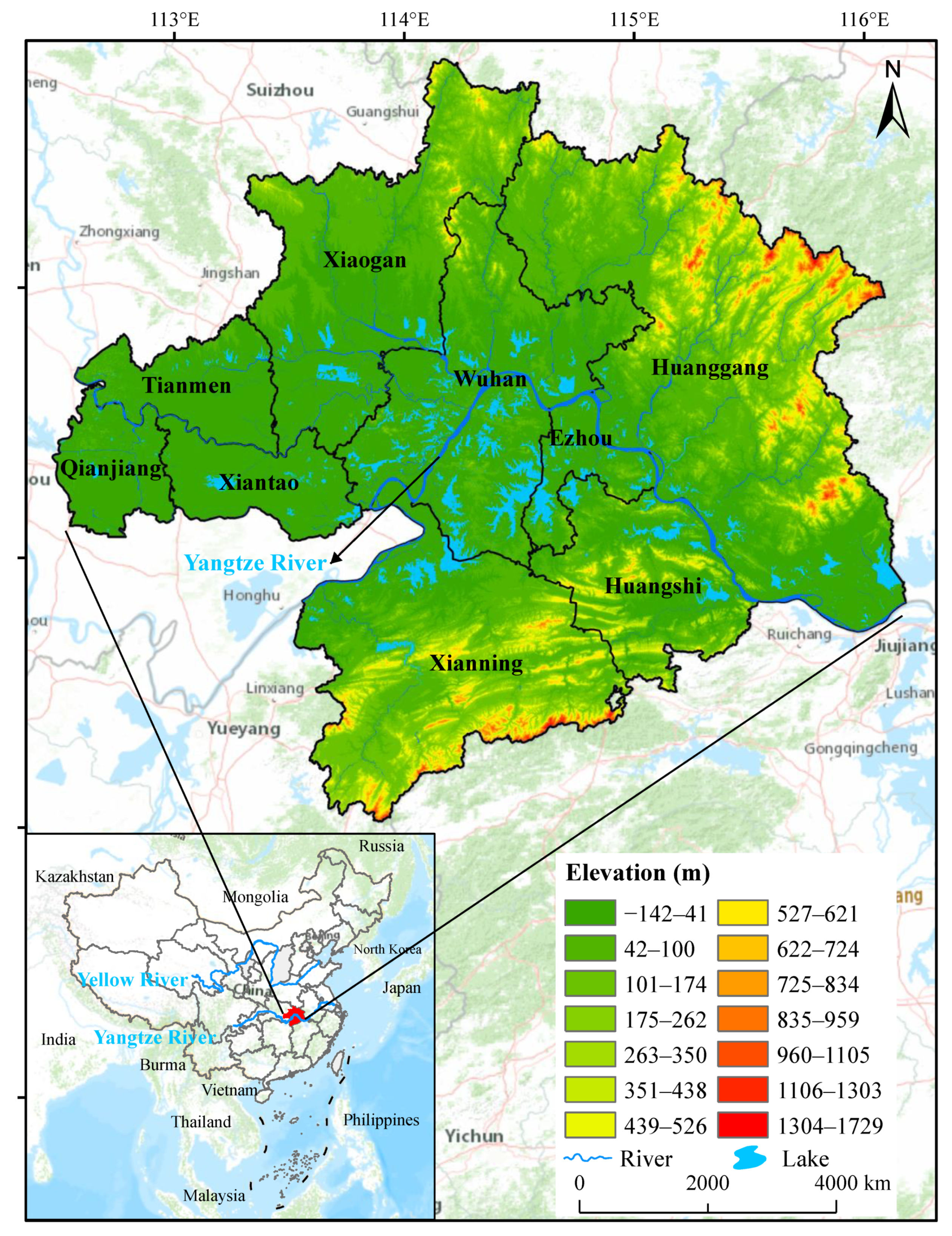
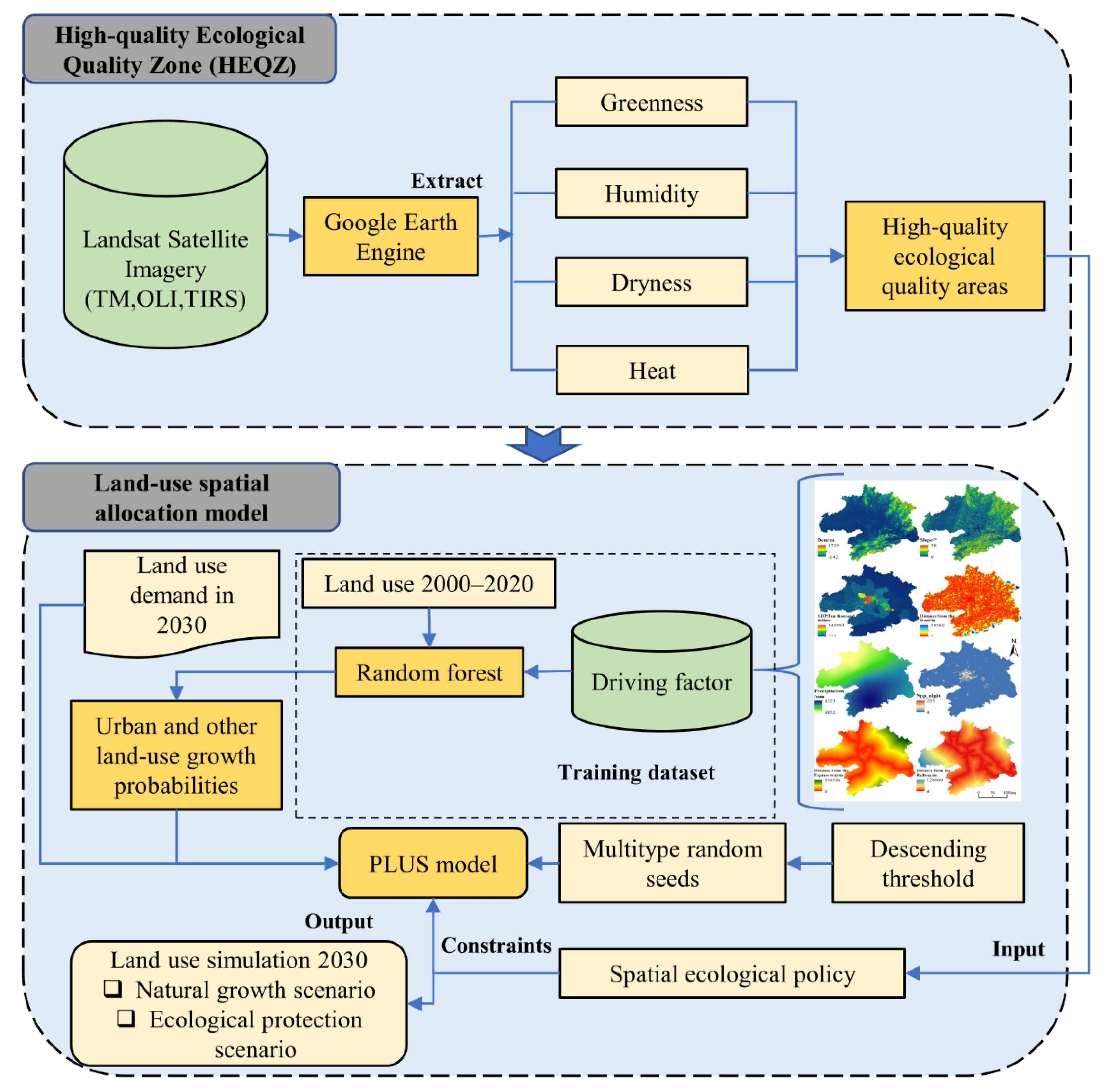

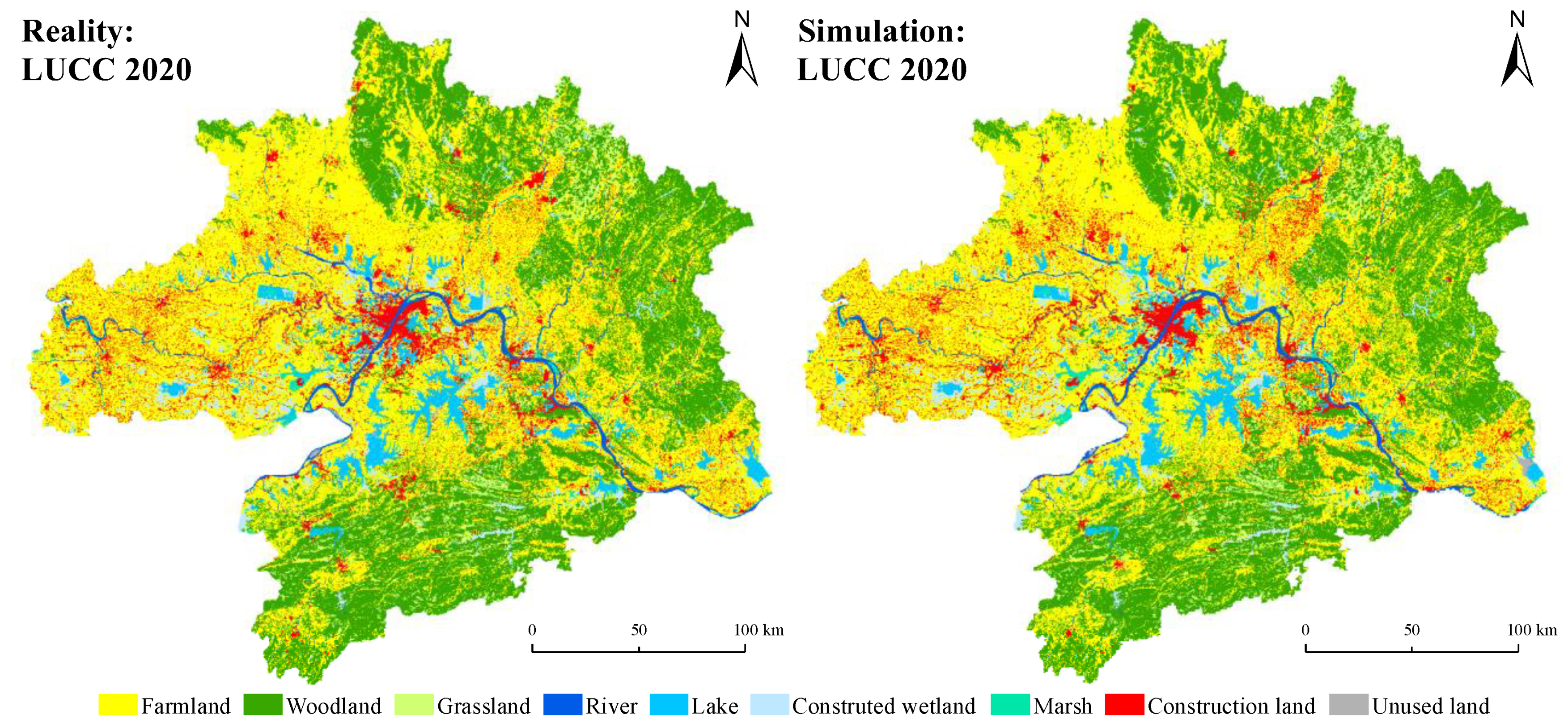
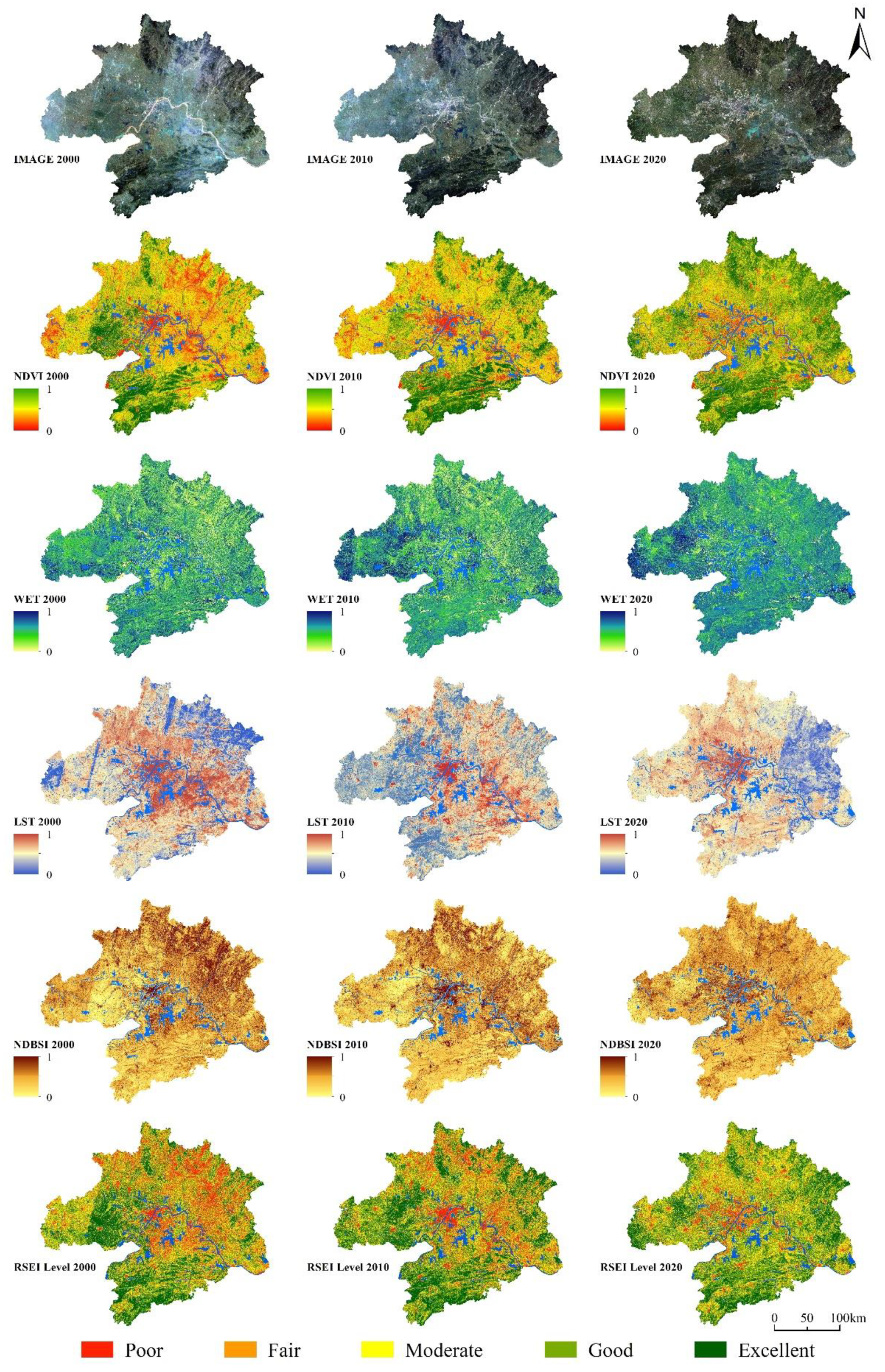
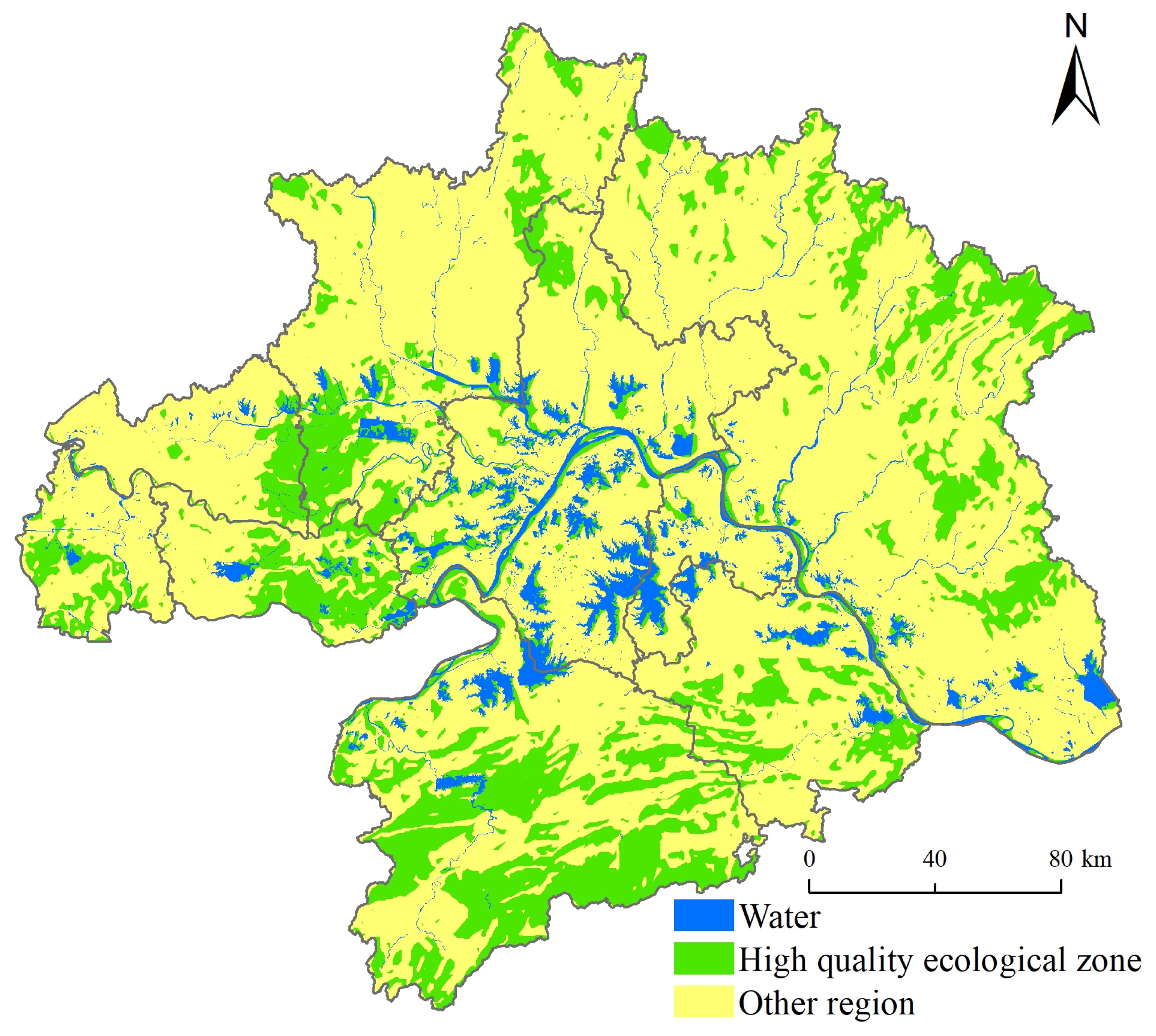
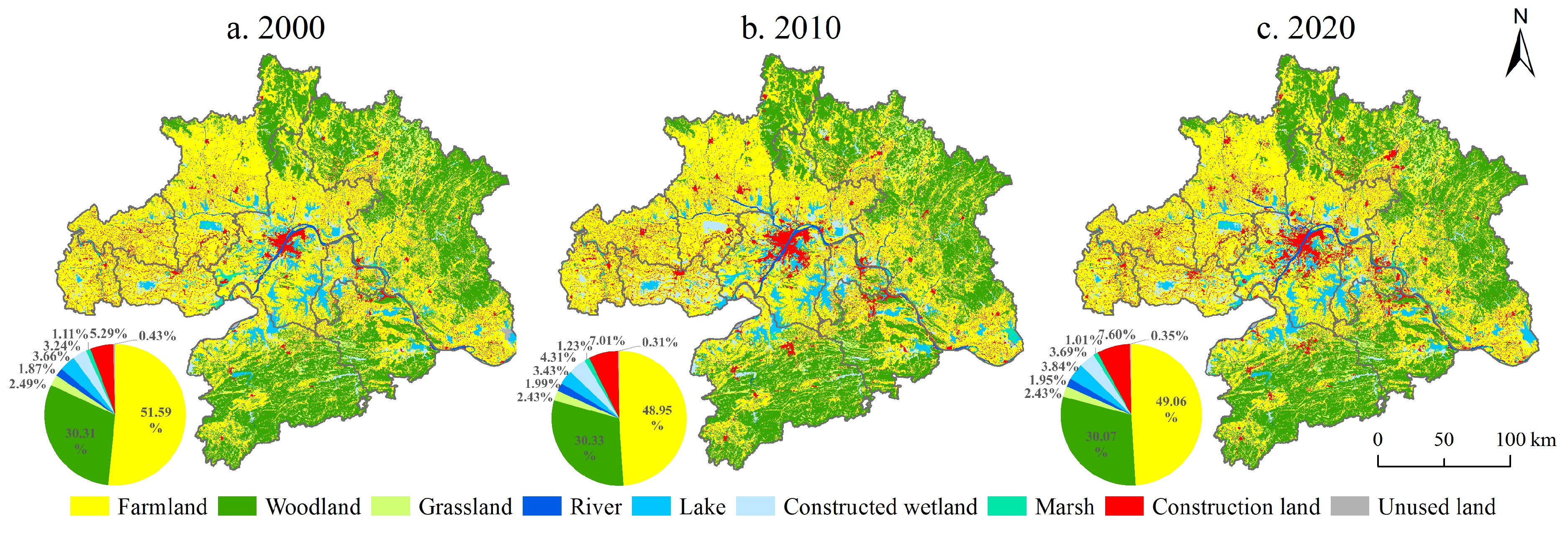
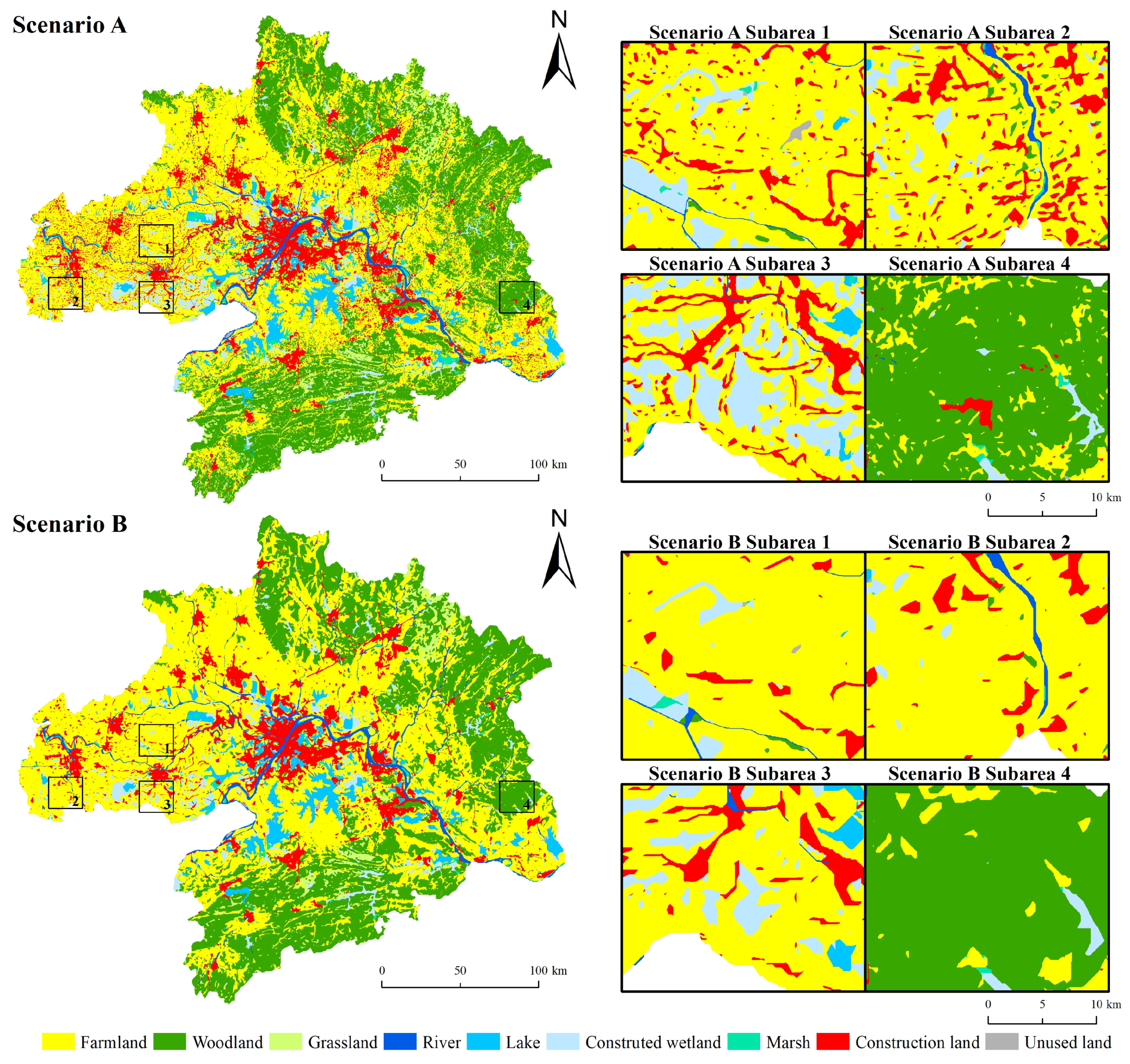
| 2000 Landscape Types | 2010 Landscape Types | |||||||||
|---|---|---|---|---|---|---|---|---|---|---|
| Cropland | Woodland | Grassland | Rivers | Lakes | Artificial Wetland | Marsh Wetlands | Construction Land | Unused Land | Outflow | |
| Cropland | 0.56 | 0.04 | 0.06 | 0.10 | 1.08 | 0.24 | 1.49 | 0.03 | 3.61 | |
| Woodland | 0.32 | 0.05 | 0.01 | 0.01 | 0.05 | 0.01 | 0.25 | 0.00 | 0.69 | |
| Grassland | 0.02 | 0.09 | 0.00 | 0.00 | 0.01 | 0.01 | 0.03 | 0.00 | 0.17 | |
| Rivers | 0.07 | 0.00 | 0.00 | 0.00 | 0.01 | 0.08 | 0.01 | 0.00 | 0.17 | |
| Lakes | 0.09 | 0.00 | 0.00 | 0.03 | 0.37 | 0.21 | 0.07 | 0.02 | 0.80 | |
| Artificial wetland | 0.16 | 0.02 | 0.00 | 0.04 | 0.17 | 0.19 | 0.06 | 0.03 | 0.67 | |
| Marsh wetlands | 0.15 | 0.00 | 0.00 | 0.14 | 0.21 | 0.15 | 0.03 | 0.02 | 0.70 | |
| Construction land | 0.15 | 0.02 | 0.00 | 0.01 | 0.03 | 0.02 | 0.01 | 0.00 | 0.23 | |
| Unused land | 0.02 | 0.00 | 0.00 | 0.00 | 0.04 | 0.05 | 0.09 | 0.01 | 0.22 | |
| Inflow | 0.96 | 0.71 | 0.11 | 0.29 | 0.56 | 1.75 | 0.82 | 1.95 | 0.11 | 7.26 |
| 2010 Landscape Types | 2020 Landscape Types | |||||||||
|---|---|---|---|---|---|---|---|---|---|---|
| Cropland | Woodland | Grassland | Rivers | Lakes | Artificial Wetland | Marsh Wetlands | Construction Land | Unused Land | Outflow | |
| Cropland | 0.95 | 0.05 | 0.11 | 0.14 | 0.39 | 0.16 | 1.82 | 0.03 | 3.65 | |
| Woodland | 1.16 | 0.15 | 0.01 | 0.02 | 0.07 | 0.01 | 0.25 | 0.00 | 1.67 | |
| Grassland | 0.06 | 0.14 | 0.00 | 0.00 | 0.00 | 0.00 | 0.03 | 0.00 | 0.23 | |
| Rivers | 0.10 | 0.01 | 0.00 | 0.04 | 0.03 | 0.08 | 0.01 | 0.00 | 0.27 | |
| Lakes | 0.12 | 0.01 | 0.00 | 0.00 | 0.17 | 0.08 | 0.05 | 0.01 | 0.45 | |
| Artificial wetland | 0.75 | 0.08 | 0.01 | 0.02 | 0.36 | 0.12 | 0.10 | 0.04 | 1.47 | |
| Marsh wetlands | 0.21 | 0.01 | 0.01 | 0.07 | 0.24 | 0.12 | 0.03 | 0.03 | 0.71 | |
| Construction land | 1.33 | 0.21 | 0.02 | 0.02 | 0.04 | 0.05 | 0.02 | 0.01 | 1.71 | |
| Unused land | 0.04 | 0.00 | 0.00 | 0.00 | 0.01 | 0.02 | 0.02 | 0.01 | 0.09 | |
| Inflow | 3.76 | 1.41 | 0.24 | 0.23 | 0.86 | 0.85 | 0.49 | 2.30 | 0.12 | 10.26 |
Publisher’s Note: MDPI stays neutral with regard to jurisdictional claims in published maps and institutional affiliations. |
© 2022 by the authors. Licensee MDPI, Basel, Switzerland. This article is an open access article distributed under the terms and conditions of the Creative Commons Attribution (CC BY) license (https://creativecommons.org/licenses/by/4.0/).
Share and Cite
Li, J.; Gong, J.; Guldmann, J.-M.; Yang, J.; Zhang, Z. Simulation of Land-Use Spatiotemporal Changes under Ecological Quality Constraints: The Case of the Wuhan Urban Agglomeration Area, China, over 2020–2030. Int. J. Environ. Res. Public Health 2022, 19, 6095. https://doi.org/10.3390/ijerph19106095
Li J, Gong J, Guldmann J-M, Yang J, Zhang Z. Simulation of Land-Use Spatiotemporal Changes under Ecological Quality Constraints: The Case of the Wuhan Urban Agglomeration Area, China, over 2020–2030. International Journal of Environmental Research and Public Health. 2022; 19(10):6095. https://doi.org/10.3390/ijerph19106095
Chicago/Turabian StyleLi, Jingye, Jian Gong, Jean-Michel Guldmann, Jianxin Yang, and Zhong Zhang. 2022. "Simulation of Land-Use Spatiotemporal Changes under Ecological Quality Constraints: The Case of the Wuhan Urban Agglomeration Area, China, over 2020–2030" International Journal of Environmental Research and Public Health 19, no. 10: 6095. https://doi.org/10.3390/ijerph19106095
APA StyleLi, J., Gong, J., Guldmann, J.-M., Yang, J., & Zhang, Z. (2022). Simulation of Land-Use Spatiotemporal Changes under Ecological Quality Constraints: The Case of the Wuhan Urban Agglomeration Area, China, over 2020–2030. International Journal of Environmental Research and Public Health, 19(10), 6095. https://doi.org/10.3390/ijerph19106095








